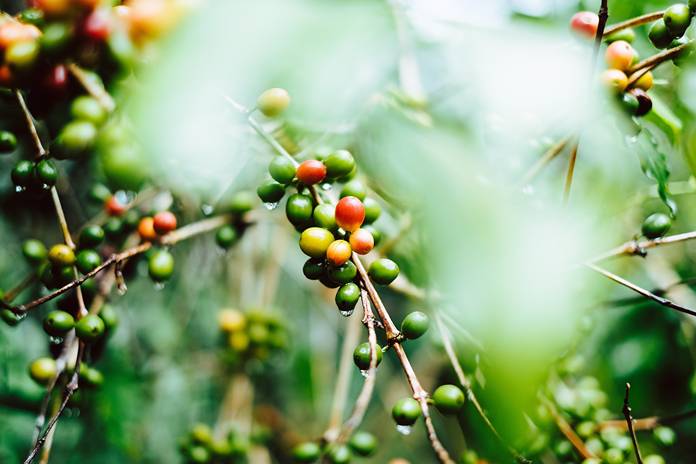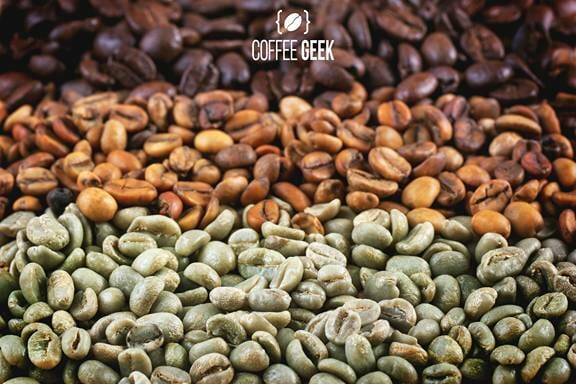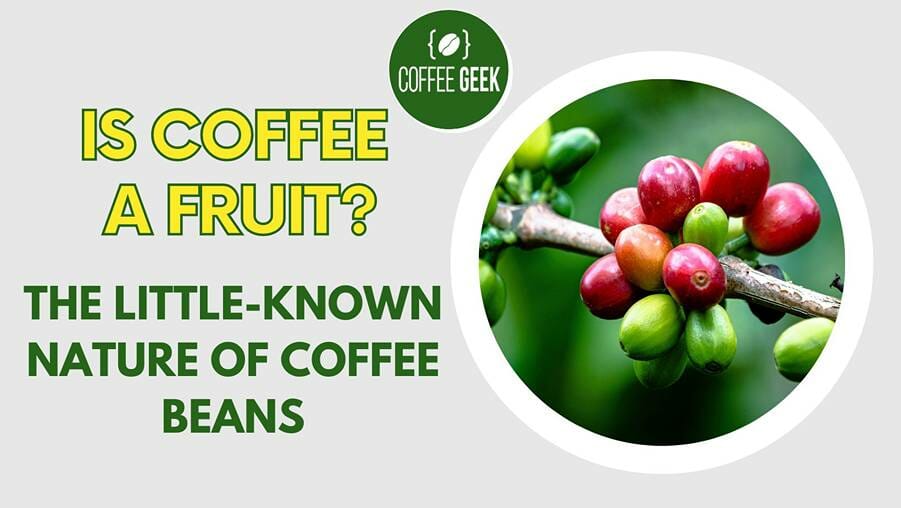We know how you feel. There you were, just minding your own business, when someone or one of their lovely little internet knowledge bombs went off in your head.
“Did you know that in reality coffee is a fruit?”
There. It happened. You’re incepted now, and you’re gonna have to find out for yourself before you can resume your normal human functionality and live your life.
We get it. We’ve been there. And we’ve got your back. We’ll make this as quick and easy as possible for you.
Is coffee a fruit? Well, yes and no.
I know. We’re sorry. But it’s true. Allow us to briefly explain.
Is Coffee a Fruit, Nut, Seed, or Something Else?

When you ask that question, you’re more than likely envisioning coffee beans.
We’re going to go ahead and give you the benefit of the doubt and assume you’re not wondering whether a cup of coffee is a fruit. That would make us sad.
Here’s the deal: actual coffee beans are not a fruit. But believe it or not, coffee is a fruit—just not in any form you’ve likely ever used or seen it in.
Wait, what?
Many people assume (rightfully so considering what we call them) that coffee beans are, well, beans. They are not. Nor are they nuts, which is a popular second guess.
You’d be forgiven for either misconception though, because if you’ve ever seen green coffee beans in particular you’d know that they share a lot, appearance-wise, with raw nuts.
In fact, in certain lighting, they look an awful lot like peanuts.
But neither green coffee beans nor the roasted beans that eventually become your beloved morning cup of coffee are nuts or beans.
How Coffee is a Fruit?

So coffee beans aren’t technically beans, but they are in fact seeds!
These coffee seeds grow inside coffee fruit—called coffee cherries or coffee berries—which themselves grow on the coffee plant (which is technically spelled coffea).
This coffee tree—which grows very much above-ground, unlike the plants that produce most actual beans—produces beautiful little bushels of the tiny fruits called the coffee cherry.
They start off an earthy green when young, and then ripen into a beautifully vibrant shade of red.
Coffee beans grow inside them, which makes them seeds and coffee is technically a fruit!
Coffee Cherry to Coffee Bean
To get from coffee plants to coffee cherries and eventually to those lovely roasted coffee beans we churn into our cherished liquid coffee takes quite the process.
The Coffee Fruits Lifecycle

Coffee plants grow either in the wild or on a coffee farm.
They bear fruit in the form of coffee cherries, which start out green and then ripen into a lush ruby red.
The coffee fruit is harvested and sent for processing.
The fruity flesh is then removed either physically, through intense washing, or by being dried out.
This releases the raw green coffee bean from the fruit.
The green coffee beans are then roasted to different degrees in order to produce the full range of products we use for brewing coffee, from arabica beans to robusta beans.

What About Using the Whole Cherry Coffee?
There are actually an increasing number of coffee drinks you can find around the world that utilize the entire coffee fruit!
These exotic beverages pack the caffeine and antioxidants many of us love knowing is in a simple cup of arabica coffee, while also adding additional nutrients and a fruitier taste.
Why Don’t We See Green Coffee Beans?
If you’re interested in this we highly recommend taking a look at our other recent article all about eating coffee beans, in which we dive into the differences between green coffee beans and roasted coffee beans more thoroughly.
Suffice it to say though, that the raw green coffee bean is not a pleasant food to snack on or make beverages from, most of the time.
While green coffee extract has become a very trendy ingredient in certain processed superfood supplements and even skincare products, a regular coffee bean that hasn’t been roasted has a very earthy taste and a tough, rubbery texture.
The roasting process brings out the best of the green bean whether for drinks or snacks.
Health Benefits of Coffee Cherries
Just like coffee beans themselves, whether consumed whole or after grinding and brewing into black coffee, those yummy-looking coffee cherries have tons of health benefits, similar to and often exceeding those of herbal tea.
We’ve summarized a bunch of them, backed up by WebMD.
Potential Positive Health Effects of Coffee Fruits
Coffee fruit is known to help with blood pressure
The coffee cherry has a ton of antioxidants
Coffee berries help in managing weight loss
Fruit from the coffee plant is associated with cancer-preventing effects
The coffee cherry (and the coffee bean inside) has cognitive-boosting and brain-protective effects
Coffee fruit has anti-aging properties
But beware that the health benefits of consuming any part of the coffee plant are offset by potential negatives if you overdo it.
Too much coffee in your diet, in any form, can result in heart problems, hypertension, anxiety, insomnia, and even withdrawal symptoms if you cut back too harshly after overdoing it.
So remember everything in moderation. Even coffee.
Wrap-Up: The Coffee Fruit That Isn’t a Coffee Bean at All
When you go to make your morning coffee, you’re using coffee grounds that have been made from roasted coffee beans.
Those coffee beans grow inside the coffee fruit, known as the coffee cherry, and start out as green coffee “beans” that are actually the seeds inside that coffee cherry.
The coffee fruit, sometimes also called coffee berries, grows on bush-like coffee plants, and it’s technically the fruit’s roasted seeds that eventually become the arabica coffee beans you’re likely brewing.
So the coffee you’re used to using isn’t a fruit. But it’s part of one. And it definitely isn’t a bean.



